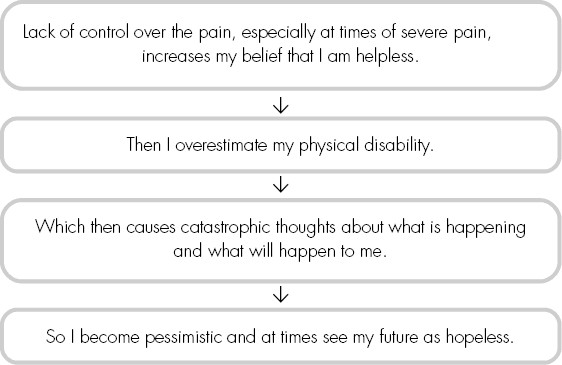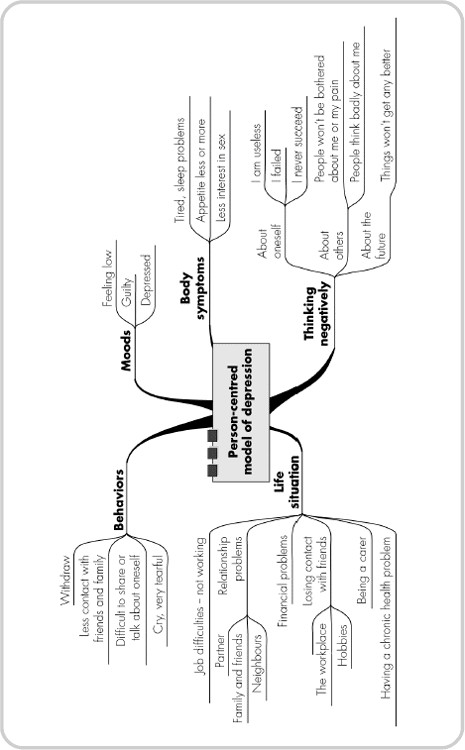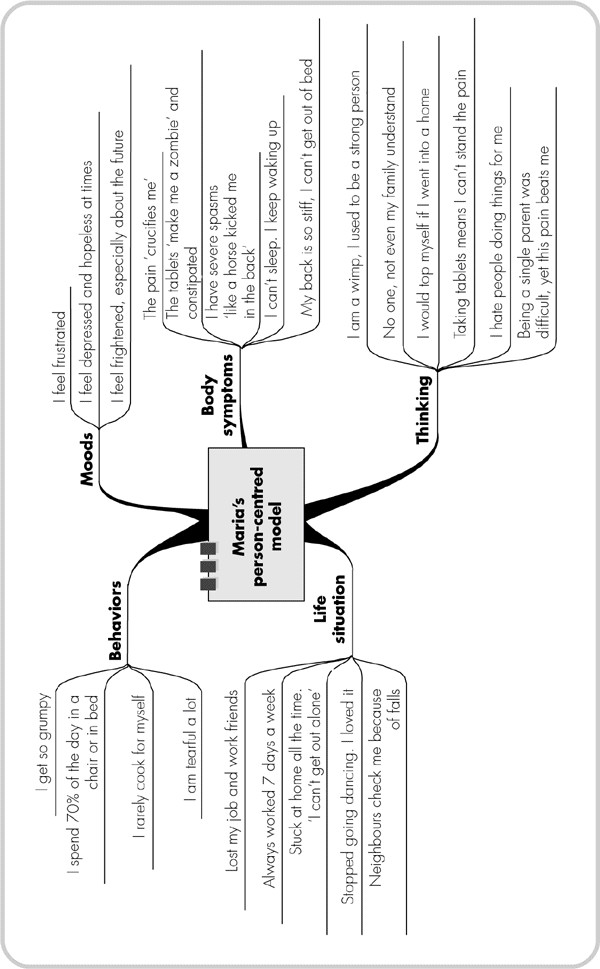
- •Other titles in the series include:
- •Overcoming chronic pain a self-help manual using Cognitive Behavioral Techniques frances cole, helen macdonald, catherine carus and hazel howden-leach
- •Isbn: 978-1-84119-970-2 eIsbn: 978-1-47210-573-8
- •Table of contents
- •Acknowledgements
- •Foreword
- •Introduction by Peter Cooper Why cognitive behavioral?
- •Introduction
- •Who might benefit from using this book?
- •What does chronic pain mean?
- •What is Cognitive Behavioral Therapy?
- •How can a book help?
- •How can I get the most out of using this book?
- •What do the chapters cover?
- •How do I start using this book?
- •Four case histories
- •Using the person-centred model
- •Maria and the person-centred model
- •How did the model help Maria make changes for the better?
- •How can the person-centred model help you get ready tomake some changes?
- •Getting started
- •Reducing the impact of pain on your daily life
- •How do you or others see these changes occurring?
- •Understanding chronic pain and pain systems
- •Understanding pain
- •Acute and chronic pain
- •What is acute pain?
- •What is chronic pain?
- •Acute and chronic pain systems
- •The acute pain system
- •The chronic pain system
- •Theories of pain The Gate Control Theory of Pain
- •Other theories of pain
- •Frequently asked questions
- •Understanding investigations for pain
- •Blood tests
- •Waiting for tests and results
- •Understanding the roles of healthcare professionals
- •Healthcare professionals
- •What is the role of a physiotherapist?
- •How do physiotherapists work?
- •What is the role of a specialist pain nurse?
- •What is the role of a pain specialist?
- •What is the role of a psychologist?
- •What is the role of a psychiatrist?
- •Talking therapies
- •Cognitive Behavioral Therapy
- •Pain management programmes
- •Understanding medicines and using them better
- •What types of medicines are used to manage chronic pain?
- •How are medicines used? Analgesics
- •Problems with medicines
- •Making better use of medicines
- •Four suggestions for using medications more helpfully
- •Stopping or reducing your medicines
- •Part two Overcoming Chronic Pain
- •Introduction
- •Setting goals
- •What are goals?
- •Informal and formal goals
- •What are smart goals?
- •Setting goals
- •Using a goal ladder
- •Achieving your goals
- •Giving yourself rewards
- •What are rewards?
- •Creating a ‘fun presciption’
- •50 Mg of fun three times a day (at least) For maximum benefit, use imagination!
- •Understanding pacing skills
- •What is pacing?
- •What are the different styles of pacing?
- •What type of pacing style do you use at present?
- •If pain levels are low, do you:
- •If pain levels are high, do you:
- •How to change your pacing style
- •Experimenting
- •Planning
- •Priorities
- •How to deal with barriers to realistic pacing
- •Getting fitter and being more active
- •How being more active can help you manage your pain
- •Trying to get fitter: What does having more pain mean?
- •Why do these types of activity cause aches and pains?
- •Assessing your present activity level
- •Frequently asked questions about increasing physical activity
- •How to get started on a basic exercise programme
- •Strength exercises – do slowly
- •Stretches for flexibility
- •Understanding problem-solving
- •What is problem-solving?
- •The main steps in problem-solving
- •Putting the problem-solving process into practise
- •Problem-solving guide
- •Understanding sleep and sleep problems
- •What sort of sleeping problems can be caused by chronic pain?
- •What kind of sleep pattern do you have at present?
- •How much sleep do you need?
- •How to use a sleep diary
- •How can you change unhelpful sleep habits?
- •Relaxation
- •What is relaxation?
- •How can relaxation help with chronic pain?
- •What can help you relax?
- •How to practise relaxing
- •Time out relaxation
- •What can make it difficult to practise relaxation?
- •Pain, communication and relationships
- •Part 1: communication and sharing concerns How close relationships can be affected by pain
- •How to manage difficulties in relationships
- •How to change behavior
- •How to communicate and share your concerns
- •Part 2: chronic pain and sexual relationships
- •How to deal with sexual problems
- •How to make sexual relationships easier
- •Managing depression, anxiety and anger
- •What moods can occur because of pain?
- •Part 1: managing depression
- •Why do people become depressed with chronic pain?
- •How depression affects people’s thinking
- •What factors can contribute to depression?
- •Unhelpful thinking in depression
- •Using anti-depressants
- •Part 2: managing anxiety
- •What is anxiety?
- •What are the effects of anxiety?
- •How does anxiety affect the body?
- •Anxiety and chronic pain
- •Managing anxiety by dealing with unhelpful thinking
- •Overcoming avoidance
- •Changing unhelpful behaviors
- •Part 3: managing anger
- •How anger affects you and your pain
- •How chronic pain and anger are linked
- •How being angry can affect other people
- •How to manage anger better
- •A coping plan
- •Acceptance
- •What is acceptance?
- •How can acceptance help you manage chronic pain?
- •What is attentional control or mindfulness?
- •1. Reasonable (thinking reasonably)
- •2. Emotional (thinking emotionally)
- •3. Wise (being mindful)
- •Mindfulness skills
- •1. Observing
- •2. Being ‘non-judgemental’
- •3. Focusing on one thing now and being in the present
- •4. Doing what works
- •Mindfulness exercises
- •Maintaining progress and managing setbacks
- •How can you maintain progress?
- •Obstacles to progress
- •What is a setback?
- •How can you manage a setback?
- •Looking to the future and managing work
- •How are new ways of life and new roles possible?
- •How can you use a positive data log?
- •Thinking through work, training and other options
- •How can you stay at work or return to work successfully?
- •Useful information
- •Professional organizations
- •Self-help groups and organizations
- •Books and publications
- •Self-help books
- •Tapes and cDs
- •Useful videos
- •Wordlist
Managing depression, anxiety and anger
This chapter aims to help you understand:
• What moods can happen with chronic pain
• More about moods, such as depression and guilt, anxiety, worry and fear, anger and frustration
• How to manage these moods in helpful ways by using a Thought Challenge Worksheet
What moods can occur because of pain?
The most common moods that occur because of chronic pain are:

Circle those moods on the previous page that you feel are linked with your pain problem, and add your own mood experiences.
Pain is not just a physical event. It affects:
• Our moods and emotions or feelings
• Our thinking about ourselves, other people and the future
• The things we do or stop doing (our behaviors)
• Our relationships with others, including partner, family and friends
This chapter is divided into Part 1 (‘Managing Depression’), Part 2 (‘Managing Anxiety’) and Part 3 (‘Managing Anger’).
Part 1: managing depression
This section aims to help you understand:
• Why people become depressed with chronic pain
• How depression affects people’s thinking
• What factors can contribute to depression
• How to manage depression
Depression is very common – 1 in 10 people have depression at any one time. Count the next 10 people you see and remind yourself that one of them could be depressed. However you might not know, by looking at them, that they were depressed. Depression is a little like chronic pain. Only you know how it feels and other people may not notice or understand it. If they do notice, what they may see is a quieter, more withdrawn person who seems:
• To laugh less
• To be tearful sometimes, or look or sound tired
• Be forgetful or lacking in concentration
• Unwilling to do things or join in with others
• To lack confidence
• To be less interested in sex or intimacy
• To feel guilty and low
• To be negative or pessimistic, sometimes hopeless, about the future
If you experience any of these changes yourself for two weeks or longer, then you may have depression.
Why do people become depressed with chronic pain?
Persistent pain is very stressful and exhausting. Feelings of helplessness and frustration can contribute to low mood. Sleep patterns are upset. Tiredness can set in and this too can lower mood. There are many changes and losses, such as work or friends, or being less active and able to do things with others.
How depression affects people’s thinking
Depression in chronic pain can cause specific changes in how people think, leading to a negative ‘chain reaction’:

What factors can contribute to depression?
Tick any factors that you feel are important for you:
Life events
Financial difficulties
Bereavements
Relationship difficulties
Work stresses
UNHELPFUL BEHAVIORS
Reduced levels of physical activity and ability to do things, e.g. driving, gardening
Drinking too much alcohol, or using drugs like heroin or cocaine
LOSSES, SUCH AS
Your job
Some of your friends
Some of your family members
Your role or main purpose in life
Your health
Your plans or goals in life, especially future goals
OTHER PROBLEMS
Lack of sleep and frequent tiredness
Side-effects from medicines for pain-relief or lowering blood pressure (e.g. beta-blockers)
Changes in your thinking that become extreme and negative
Others? _______________________
If you are depressed, write in your notebook any factors that you think may be linked to your own depressed mood.
Depression can affect all five ‘parts’ of the person: their thinking, moods, behaviors, their body symptoms and their current life situation. This is shown in the person-centred model on the opposite page.
Add any additional symptoms you may have to this person-centred model.
The person-centred model can help you to see how to change your moods. Changing one part can enable the other parts to change. For example, if sleep is a problem, improving it may make you feel more energetic (body symptom) and more enthusiastic (mood). You may be able to do a few more activities at home with family or friends (behavior). You might then think: ‘I am glad I can do this and the family are supportive’ (more positive thinking).
The person-centred model on the next page shows the impact of chronic pain on Maria, her life, her moods, thoughts and behaviors. For example, it shows Maria:

• Not doing activities with and for other people
• Several life situation factors that play a part in her depression (for example, being stuck at home all the time)
This model shows the link between Maria’s chronic pain and her depression. (See page 201.) It helps to see possible areas to lessen and manage depression.
HOW UNHELPFUL THOUGHTS ARE LINKED TO DEPRESSION AND CHRONIC PAIN
In any situation, people try to make sense of what is happening by asking, ‘Why me?’ or ‘What if . . .?’ With chronic pain, your thoughts or beliefs about yourself, your illness and your health, and your ability to cope, may all be challenged. When people with chronic pain are depressed, they sometimes:
• Think they are useless or not needed
• Make assumptions about what others might think about them and their pain problem
• Have thoughts like ‘I am helpless’ about their pain control and their situation
• Avoid being with others
In depression, people frequently have negative and pessimistic thoughts. They also often find they have more memories of difficult and negative experiences, rather than pleasant or positive ones.

